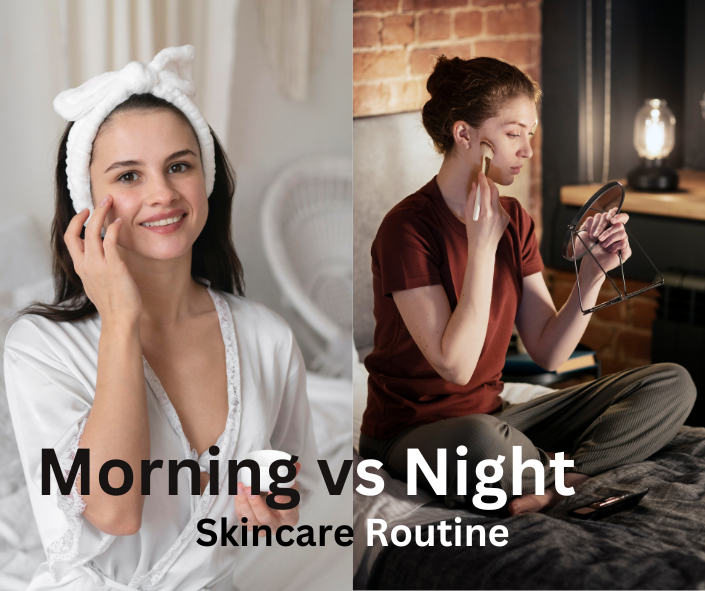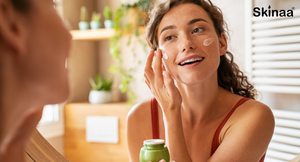When it comes to skincare, the time of day plays a significant role in how you should treat your skin. Your skin has different needs during the day compared to at night, and understanding these differences can help you tailor your skincare routine for maximum results. Let’s dive into the essential steps for both morning and night routines, and how you can get the most out of each.
The Importance of a Morning Skincare Routine
Your morning skincare routine is all about protection. During the day, your skin faces numerous external stressors such as UV rays, pollution, and dirt. The goal is to create a shield that keeps your skin safe while ensuring it stays hydrated and radiant.
1. Cleanse: Start Fresh
While your skin isn't exposed to as much dirt and grime overnight, it still produces oils and sheds skin cells. Start your day by cleansing with a gentle cleanser to remove any buildup and refresh your skin.
- Recommended for all skin types: A mild, non-stripping cleanser that leaves the skin feeling clean but not tight.
2. Toner: Balance and Prep
Toners help to restore your skin's pH balance after cleansing and prepare it for better absorption of the following products. Depending on your skin type, you can choose a toner that hydrates, balances oil production, or soothes sensitivity.
- Pro tip: Look for toners with antioxidants, like vitamin C, to add an extra layer of protection against free radicals.
3. Serum: A Boost of Antioxidants
In the morning, it's all about protecting your skin from environmental damage. A vitamin C serum is your best friend here, as it brightens the skin, evens out skin tone, and fights off free radical damage caused by pollution and sunlight.
- For extra benefits: If your skin is prone to redness or irritation, add a serum with niacinamide to calm the skin.
4. Moisturizer: Lock in Hydration
Moisturizer is essential to keep your skin hydrated throughout the day. Even if you have oily skin, a lightweight, oil-free moisturizer will ensure that your skin stays hydrated without becoming greasy.
- Pro tip: Choose a moisturizer with added SPF for an extra layer of sun protection.
5. Sunscreen: The Ultimate Protector
The final and most crucial step of any morning routine is sunscreen. SPF is your skin’s best defense against harmful UV rays that cause premature aging, hyperpigmentation, and even skin cancer. Make sure to apply a broad-spectrum sunscreen with at least SPF 30 or higher.
- Pro tip: Don’t forget your neck, ears, and hands — these areas are also prone to sun damage.
The Role of a Night Skincare Routine
Your nighttime skincare routine is about repair and restoration. While you sleep, your skin is in recovery mode, repairing damage, generating new cells, and absorbing nutrients. Nighttime is the best opportunity to focus on treating specific skin concerns like aging, acne, or dehydration.
1. Cleanse: Remove the Day
Cleansing at night is non-negotiable. It’s important to remove all the makeup, sunscreen, and impurities accumulated during the day. Double cleansing — starting with an oil-based cleanser followed by a water-based cleanser — ensures your skin is thoroughly clean without being stripped of its natural oils.
- Pro tip: Make sure to cleanse gently, especially around the eyes, to avoid irritating the delicate skin.
2. Toner: Soothing and Restorative
After cleansing, use a toner to restore hydration and soothe the skin. At night, you can opt for toners that focus more on nourishing and hydrating the skin rather than oil control.
- Extra boost: Toners with hyaluronic acid can attract moisture to the skin, providing extra hydration while you sleep.
3. Treatment Serums: Target Skin Concerns
Nighttime is the ideal moment to use treatment serums that address specific skin concerns like fine lines, pigmentation, or acne. This is when your skin is most receptive to active ingredients like retinol, AHA/BHA acids, and peptides, which help accelerate skin regeneration and exfoliation.
- Pro tip: If you're using retinol, make sure to follow up with a good moisturizer to avoid dryness and irritation.
4. Eye Cream: Care for Delicate Skin
The skin around your eyes is thinner and more prone to dryness and wrinkles. An eye cream can help reduce puffiness, dark circles, and fine lines.
- Pro tip: Look for eye creams with ingredients like peptides and caffeine to target specific issues like under-eye bags and fine lines.
5. Moisturizer or Night Cream: Repair and Hydrate
Your nighttime moisturizer should focus on repairing and replenishing the skin. Night creams tend to be richer and more hydrating than day creams. They often contain ingredients like peptides, ceramides, and hyaluronic acid to support your skin’s repair process.
- Pro tip: If you have oily skin, opt for a lightweight, non-comedogenic night moisturizer that won’t clog your pores.
6. Facial Oils or Masks: Overnight Nourishment
For an extra layer of hydration and repair, you can use a facial oil or an overnight mask. These products work throughout the night to deeply nourish the skin, ensuring you wake up with a refreshed and glowing complexion.
- Pro tip: Facial oils with ingredients like rosehip or marula oil can lock in moisture without making your skin greasy.
Morning vs. Night: Key Differences
While both morning and night skincare routines are essential, their purposes differ significantly:
-
Morning Routine: Focuses on protection from external stressors such as UV rays and pollution. It’s all about prepping the skin for the day with hydration, antioxidants, and, most importantly, sunscreen.
-
Night Routine: Centers on repair and rejuvenation. This is the time to use more potent, active ingredients like retinol and peptides that promote skin renewal and treat specific concerns.
Maximizing Your Routine
To get the most out of your skincare routines, consistency is key. Stick to a regimen that suits your skin type and lifestyle. Here are a few additional tips to help you maximize your routine:
-
Layer Products Properly: Always apply products from the thinnest to the thickest texture. Start with serums, followed by moisturizers, and then sunscreen in the morning.
-
Don’t Skip Sunscreen: Even if you're staying indoors, the sun's UV rays can penetrate through windows. Make sunscreen a daily habit.
-
Customize for Your Skin Type: Tailor your skincare routine to your skin’s needs. If your skin feels oily by midday, consider switching to lighter formulations for your morning routine. If it feels dry by morning, add an extra hydrating serum at night.
-
Stay Patient: Skin repair takes time. Give your products at least four to six weeks to show visible results before making changes.
Maximizing your skincare routine means understanding what your skin needs at different times of the day. Your morning routine should focus on protection, while your night routine should prioritize repair. With the right products and consistent care, you can achieve healthy, glowing skin that’s ready to face the world each day.









